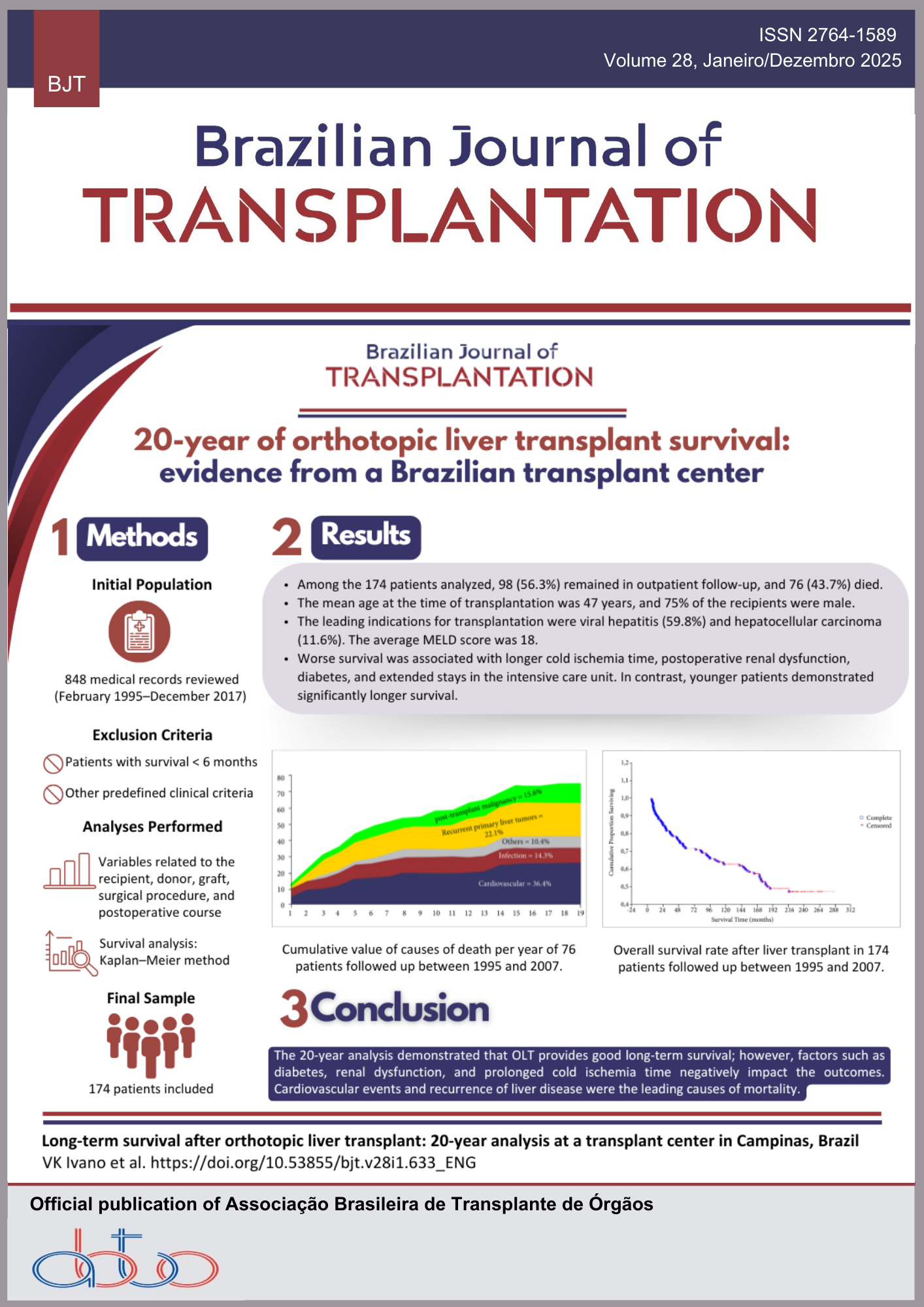Bacterial and Fungal Infections in Postoperative Liver Transplantation and Their Relationship with the Donor
Keywords:
Liver Transplantation, Infections, Organ DonorAbstract
Introduction: Nosocomial infections remain a significant cause of adverse outcomes following liver transplantation. Donor-derived infections (DDIs) are rare but potentially life-threatening in this context. Bacterial and fungal infections are among the most common forms of DDI. Given the shortage of organs and the high number of patients on the waiting list, it is crucial to determine whether the use of organs from donors with positive cultures is harmful or feasible. Objectives: To evaluate the incidence and impact of general infections, of the use of positive-culture donors, and of DDIs on liver transplant outcomes. Methods: This retrospective observational study was conducted at the Hospital Geral, Universidade de Campinas. Digital records of all transplant recipients from April 2021 to January 2024 were reviewed to identify positive cultures, records of infection at the time of positive culture, and donor cultures. DDI was considered present when patients developed infection by the same agent isolated from the donor, provided they had not been colonized before. Kaplan-Meier curves were used to define survival, with Breslow’s test for comparison between groups with or without infection and with or without positive donor cultures. Results: Ninety liver transplants were performed in 86 patients. Among the 90 donors, nine (10%) had positive cultures, and four (4.4%) met the criteria for bloodstream infection. Among the recipients, 26 (30.2%) developed infections with positive cultures during the 60 days following liver transplantation. No infections in recipients were linked to donors. There was no difference in mortality between those who received livers from positive-culture donors and negative-culture donors. Additionally, no difference in mortality was observed between those who developed infections and those who did not. Intensive care unit length of stay was higher in recipients who developed infections. Conclusion: Infections remain an important cause of postoperative morbidity among liver transplant recipients, justifying concern about DDIs. However, positive-culture donors might be suitable for transplantation when no evident sepsis is present at the time of organ harvest. The design of this study is limited, and therefore, it is imperative to confirm these findings with further prospective studies.
Downloads
References
1. Fishman JA. Infection in organ transplantation. Am J Transplant, 2017;17(4):856-79. https://doi.org/10.1111/ajt.14208
2. Chueiri Neto F, Emidio LA, Perales SR, Stucchi RSB, Dragosavac D, Falcao ALE, et al. Bloodstream infections in early postsurgery liver transplant: an analysis of 401 patients over 10 years. Transplant Proc, 2019;51(6):1972-7. https://doi.org/10.1016/j.transproceed.2019.03.040
3. Kaul DR, Vece G, Blumberg E, La Hoz RM, Ison MG, Green M, et al. Ten years of donor-derived disease: a report of the disease transmission advisory committee. Am J Transplant, 2021;21(2):689-702. https://doi.org/10.1111/ajt.16178
4. Xiao J, Wu D, Jia Y, Wan Q, Peng J. Impact of donor-derived multi-drug-resistant organism infections on abdominal solid organ transplantation recipients in China. Transplant Proc, 2021;53(6):1853-7. https://doi.org/10.1016/j.transproceed.2021.04.014
5. Tong L, Hu XG, Huang F, Huang SW, Li LF, Tang ZX, et al. Clinical impacts and outcomes with possible donor-derived infection in infected donor liver transplantation: a single-center retrospective study in China. J Infect Dis, 2020;221(Suppl 2): S164-S73. https://doi.org/10.1093/infdis/jiz591
6. Yao S, Yagi S, Sugimoto T, Asahara T, Uemoto S, Hatano E. Occult bacteremia in living donor liver transplantation: a prospective observational study of recipients and donors. Surg Today, 2024;54(6):596 605. https://doi.org/10.1007/s00595-023-02778-7
7. Wolfe CR, Ison MG, Practice ASTIDCo. Donor-derived infections: guidelines from the American Society of Transplantation Infectious Diseases Community of Practice. Clin Transplant, 2019;33(9):e13547. https://doi.org/10.1111/ctr.13547
8. Feijo MS, Galdino-Vasconcelos MR, Simoes V, Atik F, Castro FFS, Ferreira G, et al. Impact of donor positive blood culture in deceased donor liver transplantation. Transplant Proc, 2020;52(5):1236-42. https://doi.org/10.1016/j.transproceed.2020.02.027
9. Brasil. Ministério da Saúde. Agência Nacional de Vigilância Sanitária. Biovigilância no Brasil – Relatório de dados de eventos adversos 2015 a 2018. Brasília (DF): Ministério da Saúde; 2020 [cited 2024 Oct 19]. Available from: https://www.gov.br/anvisa/pt-br/centraisdeconteudo/publicacoes/monitoramento/biovigilancia/1o-relatorio-de-dados-de-biovigilancia.pdf
10. Song ATW, Yrbas MLA, Pierrotti LC, Malan R, Delfino C, Pontes DFS, et al. Global perspectives on donor-derived infections: Brazil and Argentina. Transpl Infect Dis, 2024:e14389. https://doi.org/10.1111/tid.14389
11. Centers for Disease Control and Prevention. Antimicrobial-resistant phenotype definitions. 2022 [cited 2024 Oct 19] Available from: https://www.cdc.gov/nhsn/pdfs/ps-analysis-resources/phenotype_definitions.pdf
12. Garzoni C, Ison MG. Uniform definitions for donor-derived infectious disease transmissions in solid organ transplantation. Transplantation, 2011;92(12):1297-300. https://doi.org/10.1097/TP.0b013e318236cd02
13. van Delden C, Stampf S, Hirsch HH, Manuel O, Meylan P, Cusini A, et al. Burden and Timeline of infectious diseases in the first year after solid organ transplantation in the Swiss Transplant Cohort Study. Clin Infect Dis, 2020;71(7):e159-e69. https://doi.org/10.1093/cid/ciz1113
14. Vidal E, Torre-Cisneros J, Blanes M, Montejo M, Cervera C, Aguado JM, et al. Bacterial urinary tract infection after solid organ transplantation in the RESITRA cohort. Transpl Infect Dis, 2012;14(6):595-603. https://doi.org/10.1111/j.1399-3062.2012.00744.x
15. Jafarpour Z, Pouladfar G, Malek Hosseini SA, Firoozifar M, Jafari P. Bacterial infections in the early period after liver transplantation in adults: a prospective single-center cohort study. Microbiol Immunol, 2020;64(6):407-15. https://doi.org/10.1111/1348-0421.12785
16. Bassetti M, Azoulay E, Kullberg BJ, Ruhnke M, Shoham S, Vazquez J, et al. EORTC/MSGERC definitions of invasive fungal diseases: summary of activities of the intensive care unit working group. Clin Infect Dis, 2021;72(Suppl 2):S121-S7. https://doi.org/10.1093/cid/ciaa1751
Downloads
Published
How to Cite
Issue
Section
License
Copyright (c) 2025 Felício Chueiri Neto, Ruan Tadeu Alves, Rafaela Hamada Jucá, Simone Reges Perales, Ilka de Fátima Santana Ferreira Boin, Elaine Cristina de Ataíde

This work is licensed under a Creative Commons Attribution 4.0 International License.









